Fungi
Fungi and fungal organisms are the second most numerous group of organisms on the planet after insects. Their total number is estimated at 1.5 million species. Of this estimated number, only about 5% have been validly described. Less information we have only about non-cellular organisms, of which we know about 4%. We know about 81% of taxa from vascular plants.
Of the fungi, the most severe pathogen is the Armillaria ostoyae in non-native spruces in regions of Kysuce, Orava, and Spiš. It causes roots rot; after infection of a tree, there is no effective defense method against it. It is not easy to regenerate naturally or artificially with the same wood composition the stands with the Armillaria ostoyae. The Heterobasidion annosum causes similar root damage. Technical degradation of wood is caused by fungi responsible for the core wood's white or brown rot. Serious diseases are caused by tracheomycoses, which mechanically clog vessels with their mycelium, thus inhibiting water flow from the roots to the crown. Bark necrosis and subsequent trunk cancer degrade the trunk, and infested trees can die. Lophodermium sp. causes the less dangerous diseases of fungal origin on conifers. This disease is characterized by premature browning of the needles and its fall. However, in cultures in extreme sites, also entire trees may die.
Powdery mildews are characteristic of oaks, fewer maples, and other deciduous trees. Only seedlings, plantings, or Lammas shoots, are more seriously endangered. Irregularly appears rusts on conifers, especially on pines, and sometimes on firs. They are characterized by a complex development cycle with an intermediate host. However, the risk to infected individuals is low. Phytophtora cactorum attacks seedlings and plantings in forest nurseries. When it occurs, there are extensive losses. Botrytis cinerea is a common fungus on agricultural crops, weeds, and forest woody plants. Losses on seedlings and plantings can be economically significant. Damping off is a complex of diseases characterized by sprouts rotting, strangulation of root sprouts, and death of seedlings in the summer. This group is responsible for the enormous losses of seedlings
We include 13 Phyla in the kingdom Protozoa: Amoebozoa, Apicomplexa, Cercozoa, Choanozoa, Dinozoa, Foraminifera, Fossil Amoebozoa, Granuloreticulosa, Incertae sedis (unknown taxonomic inclusion), Microspora, Myzozoa, Percolozoa, Rhizopoda. These are unicellular, plasmodial, or colonial phagotrophic organisms without or with flagella but without mastigonemes. The cell wall in the trophic stage is not present.
We include 4 Phyla in the kingdom Chromista: Oomycota, Bigyra, Fossil Oomycota, and Incertae sedis. These are unicellular, filamentous, or colonial primary phagotrophic organisms without or with flagella with mastigonemes. The cell wall is often cellulosic, chitin and β-glucans are not present. Mitochondrial cristae are tubular.
We include 14 Phyla in the kingdom Fungi: true chytrids (Chytridiomycota), zygote fungi (Zygomycota), sac fungi (Ascomycota), and basidia (Basidiomycota). Also included are Blastocladiomycota, Glomeromycota, Neocallimastigomycota, Fossil Ascomycota, Fossil Basidiomycota, Fossil Chytridiomycota, Fossil Fungi, Fossil Glomeromycota, Fossil Zygomycota, and Incertae sedis. They are unicellular or filamentous fungi, usually without flagella. If flagella are present, they do not have mastigonemes. The cell wall consists mainly of chitin and β-glucans. Mitochondrial cristae are oblate.
Phylum Ascomycota
Ascomycota is a phylum of the kingdom Fungi and the subkingdom Dikarya. Species from this group are commonly known as sac fungi. It is the largest phylum of the Fungi kingdom, with over 64 thousand species. The defining feature of this group is a sac-like structure called ascus from the Greek word ἀσκός (askos), meaning "sac" or "wineskin". The ascus is a microscopic sexual structure in which nonmotile spores, called ascospores, are formed. However, some species of the Ascomycota are asexual, meaning that they do not have (or are not known) a sexual cycle and thus do not form asci or ascospores. In the recent past, such species were classified as Deuteromycota, and at present, ascomycetes are identified and classified according to morphological and physiological similarities and phylogenetic analyzes of DNA sequences.
Ascomycetes are a monophyletic group, e.i. all species can be traced back in their phylogenetic development to a single first progenitor. The group of sac fungi is significant for humans as a source of medically essential compounds, e.g., antibiotics. They are also crucial in producing bread, alcoholic drinks, and cheeses. Unfortunately, they also cause humans and plants diseases. Fungal symbionts in most lichens, e.g., Cladonia spp., belong to the phylum Ascomycota. A large number of sac fungi are plant pathogens, e.g., powdery mildews. Some species are used as models in laboratory research, e.g., Neurospora crassa, the mold Aspergillus spp., and others are used in genetics and cell biology research. Penicillium spp., used to make cheeses or antibiotics against bacterial infections, is also a sac fungus.
Ascomycota cause diseases in some plants.
- Elm graphiosis: Tracheomycosis of elm caused by fungi of the genus Ophiostoma (Ophiostoma ulmi and Ophiostoma novo-ulmi) has decimated elm populations in North America and Europe.
- Cryphonectria parasitica, widespread from Asia, is the causative agent of Castanea sativa in Europe and Castanea dentata in North America cancer, where the tree species has almost completely disappeared from ecosystems.
- Cochliobolus heterostrophus causes the Zea mays disease, which is prevalent mainly in North America.
- Taphrina deformans causes peach leaf curl.
- Uncinula necator causes powdery mildew on grapes.
- Species of the genus Monilia cause brown fruit rot, e.g., peach, cherry.
- Stachybotrys chartarum causes fading of woolen fabrics, which is a problem, especially in tropical areas.
- Blue-green, red, and brown mould attack and cause food spoilage, e.g., Penicillium italicum causes rot of citrus fruits.
- Cereals infected with Fusarium graminearum contain mycotoxins such as deoxynivalenol (DON), which may cause wounds on the skin and mucous membranes after consumption by pigs.
- An ergot fungus Claviceps purpurea is a direct threat to humans if wheat or rice is infested, resulting in highly toxic toxins and carcinogenic alkaloids. After their consumption, ergotism develops. Symptoms of the human disease include hallucinations, spasmodic stomach pains, and limb hypersensitivity.
- Asperillus flavus attacks peanuts and other plants; it produces aflatoxins that damage the human liver and is highly carcinogenic.
- Candida albicans is a yeast that attacks the mucous membranes and can cause infections of the mouth and vagina called candidiasis and is responsible for 'yeast allergies'.
- Fungi such as Epidermophyton cause skin infections, but they are not very dangerous for people with a healthy immune system. However, if the immune system is broken and dysfunctional, these fungi can endanger a person's life. E.g., Pneumocystis jiroveci is responsible for lung infections in patients with AIDS.
Phylum Basidiomycota
Basidiomycota is one of two numerous phyla. Basidiomycota and Ascomycota form the Dikarya subkingdom; they are often referred to as the "higher fungi" within the kingdom Fungi. This group includes mushrooms, puffballs, stinkhorns, bracket fungi, other polypores, jelly fungi, boletes, chanterelles, earth stars, smuts, bunts, rusts, mirror yeasts, and Cryptococcus, the human pathogenic yeast.
Dimorphic basidiomycete with a yeast stage and the pleiomorphic rusts are examples of fungi with anamorphs in an asexual developmental stage. In some basidiomycetes, only the anamorphic stage is known. Many basidiomycetes are yeasts, called basidiomycota-yeasts, to distinguish them from ascomycete-yeasts from the Ascomycota phylum. Except for yeast anamorphs, uredinia, eecia, and pycnids, some basidiomycetes form markedly different anamorphs as a part of their life cycle. E.g., Collybia tuberosa with its apple seed shape and colored sclerotium, Dendrocollybia racemosa with its sclerotium and conidia Tilachlidiopsis racmosa, Armillaria ssp. with its rhizomorphs, Hohenbuehelia spp. with the stage of roundworms Nemactotonus spp. infection and as a parasite of coffee leaves, or Mycena citricolor and its Decapitatus flavidus shoots called gemae.
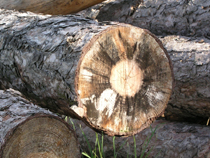 |
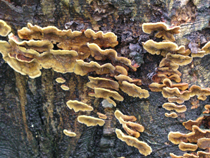 |
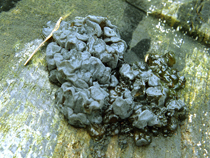 |
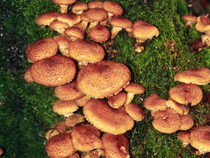 |
|
Ophiostoma. Photo: A. Kunca |
Stereum hirsutum. Photo: A. Kunca | Exidia glandulosa. Photo: A. Kunca | Armillaria mellea. Photo: A. Kunca |
Basic groups of fungi
ORDER ERYSIPHALES
The order Erysiphales belongs to the phylum Ascomycota and contains only one family, the Erysiphaceae. Many species in this order cause plant diseases called powdery mildews.
In the order Erysiphales, there is one family, Erysiphaceae, 28 genera and about 100 species. It includes many imperfect fungi (fungi whose sexual reproduction is unknown), especially the genus Oidium. Recent molecular analyzes have revealed the existence of 6 major evolutionary lineages.
Lineage 1 contains the genera Erysiphe, Microsphaera, and Uncinula, each of which also has a mitosporic stage in the genus Oidium, subgenus Pseudoidium.
Lineage 2 contains Erysiphe galeopsidis and Erysiphe cumminsiana with an anamorph of the genus Oidium of the subgenus Striatoidium.
Lineage 3 contains the Erysiphe genus with anamorphs of the Oidium genus, subgenus Reticuloidium.
Lineage 4 consists of the genera Leveillula and Phylactinia, which have an anamorph of the genera Oidiopsis, Ovulariopsis of the mitosporic stage.
Lineage 5 consists of the genera Sphaerotheca, Podosphaera, and Cystotheca, which have an anamorph of the genus Oidium, of the subgenus Fibroidium and Setoidium.
Lineage 6 contains the species Blumeria graminis, which has the anamorph Oidium, subgenus Oidium mitosporic stage. These lineages differ not only at the molecular level but also the morphological level.
Characteristics
- Teleomorphs are usually clearly different and more diverse than anamorphs. The sacs can be bitunicate or unitunicate (according to one or two layers), and it is still the subject of research.
- Cleistothecia have sacs arranged in hymenium that resembles perithecium. Cleistothecia are small and usually no larger than 0.1 mm. From the outer wall of cleistothecia grow specialized hyphae called haustoria. The number of sacs per ascoma (sporocarp, fruiting body) varies, and this feature is essential in distinguishing genera.
- Powdery mildews are remarkable for their haustorial complex that helps determine species.
- Powdery mildews have a surface mycelium that gains nutrients from the host plant by specialized hyphae that penetrate the epidermal cells of the host through an absorbent organ called a haustorium.
Host tissues are infected with sexual ascospores, or asexual conidia, germinating on the leaf or trunk surface, resulting in a compartmental mycelium with mononuclear cells. Most powdery mildews attack only epidermal cells. The external mycelium forms short upright conidiophores, each of which carries a simple series of barrel-shaped spores and the youngest spore is at the base. The infected plant parts are thus covered with conidiophores which look like white flour powder. Mature spores detach and are relatively easily carried away by the wind securing new infections. In the autumn, sexual chasmotecia are formed. Chasmotecia is the resting (hibernating) stage of a pathogen. Ascospores are dormant throughout the winter and begin to germinate in the spring; when the sacs begin to expand, the wall of the chasmotecia bursts, sending the ascospores into the air.
Erysiphales are obligate parasites on the leaves and fruits of higher plants, causing powdery mildews. Many attempts to grow powdery mildews on artificial media have failed.
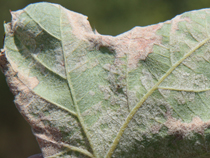 |
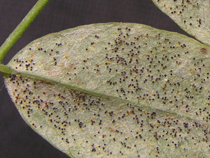 |
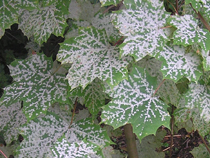 |
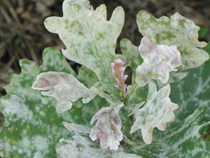 |
|
Erysiphe necator. Foto: A. Kunca |
Erysiphe palczewskii. Foto: A. Kunca | Uncinula tulasnei. Foto: A. Kunca | Microsphaera alphitoides. A. Kunca |
ORDER RHYTISMATALES
The Rhytismatales order belongs to the phylum Ascomycota. It is divided into three families, 71 genera and 411 species.
The fruiting bodies are found on dead material, usually leaves, twigs, bark, wood, or cones, rarely on berries. Although many different substrates can be populated, they are particularly numerous on conifers, grasses, and ericas (Ericaceae). As a result, they are more common in forests (especially on acid soils) than on agricultural soils. The colonized part of the plant is usually completely dead and has already fallen into the plant litter. However, there are also cases where the leaves, twigs, and bark are still attached to the tree, and sometimes they are still alive with a small dead part where the fruiting bodies of these fungi are. Some species populate healthy plant tissues as asymptomatic endobionts and produce fruiting bodies only at a certain age.
A characteristic feature of infested leaves and branches is the lighter, paler infested tissue than the tissue after infestation by other fungi. In addition, the twigs infested with these fungi are usually more fragile, so these fungi also play a role in self-cleaning the trunks from older branches. Many species form a conidial stage before the ascomata stage (ascomata), and both stages are almost equally profoundly penetrated in the host tissue. The conidial stage is usually a black pycnidium containing small single-celled conidia, presumably with a spermatia function.
The ascomata form after pycnids are bigger but also black, with a hole in the form of several cracks in the cover layer on the surface to reveal the hymenium. Paraphyses are usually present. The sacs are thin-walled with only one functional wall layer and an apex. The ascospores are almost uniformly colorless, usually without compartments, and are often long and thin. In the sexual fruiting bodies, there is almost always a gelatinous material that covers respective fills the space between ascospores and paraphyses.
The zoning lines, pycnids, and ascocarps (sexual fruiting bodies) are long-lasting and are usually visible in the field at the same time together, so the detection of the presence of these fungi can be carried out at any time of year. Furthermore, from a practical point of view, many species can be reliably identified with the help of a hand-held magnifying glass, so it is not even necessary to take samples to laboratories.
When searching for these fungi, it is necessary to know the host plant and its part where the fungus can be found (needles, leaves, bark, etc.). If the fungus is not found during the inspection, it may not be on the examined tree. In addition, determining the distribution of such fungi with permanent fruiting bodies and zones is significantly more accurate than determining the distribution of fungi from other groups with transient, short-lived fruiting bodies.
The weather significantly affects the fieldwork with these fungi. In general, bright sunny days are not suitable for observing them. Ascomata are closed, and a strong contrast between light and shadow makes it difficult to observe. Similar challenging conditions are in winter when the landscape is covered by snow or dusk when there is low visibility. The best weather for observing these fungi is a cloudy sky with enough light, or during and shortly after rain, respectively, when the snow melts quickly. It is essential to note that some species are rare and treated as unique research material.
ORDER AGARICALES
The Agaricales order, also called "gilled fungi, or gilled mushrooms," contains fungi with a characteristic shape. The order includes 33 families, 413 genera, and more than 13,000 species, including five extinct genera known only from fossils. These include common, ubiquitous fungi, deadly poisonous fungi, hallucinogenic species, fluorescent, and other characteristic groups. The fruiting bodies are fleshy, with a stalk, cap, and gills, in which basidiospores form.
In the three-volume work "Systema Mycologicum" published in 1821 and 1832, the well-known mycologist Elias Fries included almost all species with gills to the genus Agaricus. He organized this large genus into "clans," whose names are still used as genera names. Fries promoted these clans to the genera level, but other authors later, e.g., Gellet, Karsten, Kummer, Quélet, and Staude, have made several changes to this system. Fries based his classification on the macroscopic characteristics of the fruiting bodies and the color of the spore dust. His system was widely used because of its advantage in quickly identifying many genera based on characteristics visible in the location of its occurrence.
However, Fries's classification was later re-evaluated, especially after the publication of scientific works by researchers Fayod and Patouillard about microscopic structures of fruiting bodies, which indicated an unnatural association of species into common groups. In the recent past, Rolf Singer's work "The Agaricales in Modern Taxonomy", published in four editions from 1951 to 1986, uses both the macroscopic characteristics of Fries and the microscopic characteristics of Fayod in the division of families and genera. Singer's last classification thus includes 230 genera and 18 families. Singer created three main groups within the order Agaricales sensu lato:
- Agaricales sensu stricto
- Boletales
- Russulales
These groups are still accepted after verification based on DNA analyses as the euagarics clade, the bolete clade, and the russuloid clade. Molecular phylogenetic research further divided the clades into Agaricoid, Marasmioid, Pluteoid, Hygrophoroid, and Plicaturopsidoid.
The term "agaric" is traditionally understood to mean Agaricales, which usually means gilled fungi and mushrooms. However, the two categories are not synonymous, although they overlap to a large extent.
Agarics are ubiquitous on all continents. Most of them are terrestrial, growing in forests, forest steppes, and meadows. However, until 2005, gilled fungi were only considered terrestrial until the Psathyrella aquatica was discovered, producing fruiting bodies under the water.
Agarics are also known from five monotypic genera found in amber fossils. The oldest records are from the Cretaceous (Mesozoic): Palaeoagaracites antiquus from Burmese amber and Archaeomarasmius leggeti from amber from New Jersey. The other three species of Aureofungus yaniguaensis, Coprinites dominicana, and Protomycena electra come from one sample of amber from a mine in the Dominican Republic (on the island of Hispaniola in the Caribbean Sea).
The fruiting body is a life cycle structure in which spores form. Most fungi reproduce by spores, and fruiting bodies are formed for their production and spread. Spores formed in the fruiting bodies are usually the result of sexual reproduction.
The fruiting body is a visible sign of a growing fungus. It is made of an extensive network of filaments of hyphae. The nutrient-absorbing part of the fungus is called the vegetative mycelium. It is the opposite of the sporocarp, the sexual mycelium. Vegetative mycelium absorbs water and nutrients from the substrate on which it grows. If the nutrient reserve is sufficient and the conditions are favorable, some fungi can grow on the site for several years. However, fungi cannot produce food like green plants. Some species are saprotrophic and receive nutrients from dead organic material. Other species are parasitic on live plants and animals. Many species, especially gilled fungi and mushrooms, form an extensive mycelium that lives in symbiosis with roots. This symbiosis is beneficial for both the fungus and the host and is called mycorrhiza.
If the environmental conditions are favorable (humidity, light, temperature, airiness, nutrients) and the mycelium is in good condition, the fruiting bodies of the fungus are formed. However, the exact conditions for the fruiting bodies forming are unknown.
ORDER HYMENOCHAETALES
Basidiomas are gymnocarp of a crustothecium type; they may be hydnelloid, fomitoid, ganodermatoid, stereoid, or corticioid. They are spilled and cap-shaped; some are coral, annual or perennial, with a smooth or tubular hymenophore. Basidiospores are hyaline to brown, usually smooth, and rarely amyloid. They are mainly wood decay fungi causing white rot in woody plants and wood. Inonotus (14 species), Phellinus (22 species), and Coltricia (3 species) belong to the largest genera occurring in Slovakia.
Genus Inonotus
The fruiting bodies are annual, resupinate, inverted, or seemingly turned upside down, without stems (stipes), with or without a cap (the pileus). Tissue is yellowish to reddish-brown, darkening in potassium hydroxide. The surface of the cap is furry, hairy, felted, or even naked, yellowish to reddish-brown, often darkening and cracked with age. The flesh is brown, finely fibrous to hard corked. The hyphal system is monomitic to dimitic. Members of this genus have simply divided hyphae; in most species, there are thin-walled hyphae, almost hyaline to thick-walled and browned in potassium hydroxide, strongly branched; in some species are present also firming hyphae. "Sets" are present in the flesh of certain species. Hymenial bristles are present in most species. Basidia are mace-sharped, up to broadly elliptical, with four sterigmata, simply compartmentally on their base. Basidiospores are narrowly elliptical to ovate, hyaline, or golden yellow to reddish-brown, smooth, with a negative reaction in Melzer's reagent. Species cause white rot in living and dead conifers and deciduous. Eighteen species from Europe are known in this genus. The type species is Polyporus hispidus. The genus is easily recognizable by its brown, annual fruiting bodies with a fibrous to soft or fragile consistency. Hyphae are generally wider than the Phellinus genus, characterized by woody, perennial fruiting bodies, and a dimitic hyphal system.
Genus Phellinus
The fruiting bodies are permanent, resupinate to cap-shaped, growing individually or in groups. The cap, if present, is yellowish, rusty brown, gray to black, felted, bristly, smooth, or deeply cracked. The surface of the pores is brownish; the pores are irregular and square. The flesh is dark, reddish-brown, umber-like, or yellowish-brown, primarily woody, rarely hard fibrous. The hyphae system is dimitic with transitions between thin-walled generative hyphae and characteristic thick-walled skeletal hyphae. Generative hyphae are hyaline to light yellow, narrow, thin-walled, and simply compartmental. Skeletal hyphae are yellowish to rusty brown, without compartments or with occasional simple compartments, mostly thick-walled and wider than generative hyphae. Hymenial "sets" and fleshy "sets" are missing or present, and "set-hyphae" is missing or present at the edge or in the flesh of the fruiting bodies.
Spores are spherical to cylindrical, smooth, hyaline to rusty brown, thin to thick-walled, and dextrinoid to negative in Melzer's reagent. They grow on dead and living conifers and deciduous trees, causing white rot. There are 36 known species from Europe in this genus. The type species is Polyporus igniarius. The closest relative genus is Inonotus, which differs mainly in annuals and soft fruiting bodies. It is usually not an issue to distinguish these two genera in the field, but some species from the genus Phellinus with annual fruiting bodies (e.g., P. erectus) have also transitions between them hyaline generative hyphae and skeletal hyphae.
ORDER POLYPORALES
The order includes approximately 2,300 species of fungi with apparent fruiting bodies. The hymenophore is porous, lamellar, rough, smooth, or knotty. The substrate is soil or rotting wood. Some species are edible; some are pathogens of woody plants.
The order was first created in 1926 by German mycologist Ernst Albert Gäumann. The order then included ten families: Brachybasidiaceae, Corticiaceae, Clavariaceae, Cyphellaceae, Dictyolaceae, Fistulinaceae, Polyporaceae, Radulaceae, Tulasnellaceae, and Vuilleminiaceae. However, the order created this way was not generally accepted, as most mycologists preferred to use the artificially created order Aphyllophorales.
Based on molecular analyzes of DNA sequences, the boundaries of the Polyporales order have only recently been more precisely defined. These include species mainly from the families Polyporaceae, Fomitopsidaceae, and Meripilaceae. Then there is the family Ganodermataceae, which was previously in a separate order Ganodermatales due to the characteristic morphological properties of basidiospores. The Polyporales order also includes corticoid fungi of the families Cystostereaceae, Meruliaceae, Phanerochaetaceae, and Xenasmataceae, as well as cauliflower fungi/mushrooms of the family Sparassidaceae.
The Polyporales order is cosmopolitan and contains approximately 1,800 species distributed worldwide. Some species are saprophytic, others parasitic and cause wood rot.
Many species of the genera Fomes, Fomitopsis, and Ganoderma are pathogenic and cause root rot in living trees. Some species cause rot in constructing wooden beams, e.g., in mines (Androdia vaillantii). Other species are commercially grown and sold as traditional Chinese medicine, such as Ganoderma lucidum, Grifola frondosa, and Trametes versicolor.
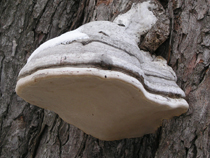 |
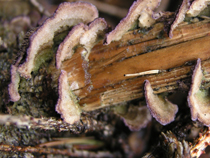 |
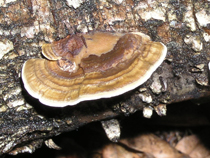 |
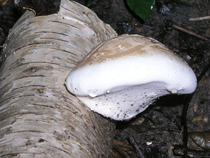 |
|
Trichaptum abietinum. Photo: A. Kunca |
Hylastes ater. Photo: A. Kunca | Daedalopsis confragosa. Photo: A. Kunca | Piptoporus betulinus. Photo: A. Kunca |
ORDER PUCCINIALES
In its most perfect complexity, rust produces five types of spores on two different hosts from unrelated host families. Such rust is:
• heteroecious - requires two hosts and
• macrocyclic - produces up to 5 types of spores.
According to the convention, the individual stages of development are numbered in Roman numerals. Basidiospores infect the first host, the mycelium forming pycnidia called spermogonia, which are tiny, bottle-shaped, hollow, submicroscopic clusters immersed in the host tissue, e.g., in the loaf. This stage, numbered "0", produces simple cells, tiny spores that slowly flow out in the sweet fluid, work as immobile spermatia, and sticking receptor hyphae. Insects and rain can carry spermatia from one spermogonium to another spermogonium, crossing mating types. No insole is male or female.
The dikaryons are formed in the second stage of development after crossing. This stage is marked in the Roman "I".
The fruiting bodies formed at this stage are called eecia. Dikaryotic aeciospores are formed in eecia in dry chains in inverted cup-shaped clusters immersed in the host tissue.
Aeciospores then infect the second host group (in macrocyclic rust). Spore stages numbered "II" are repeatedly formed on the second host, namely urediospores in dry pustules called uredines, respectively uredia. Urediospores are dikaryotic and can infect the same host on which they formed. Thus, they repeatedly infect it during the growing season.
At the end of the growing season, the fourth type of spores, the teliospores, are formed, part of the "III" stage. Teliospores are thick-walled, and their role is to overwinter, respectively survive other adverse conditions.
The infection process no longer continues; at this stage, the fungus is in dormancy, and after the conditions improve, the teliospore germinates and forms basidia, which is the "IV" stage called promycelium. Fungi of the order Pucciniales have cylindrical basidia, are three-compartmented after meiosis, and each of the four cells carries one basidiospore. Basidiospores are released, and a new infectious process begins on host one.
Autoaecial rust ends its life cycle on a single host, and macrocyclic rust skips one or more stages.
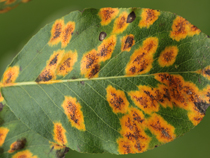 |
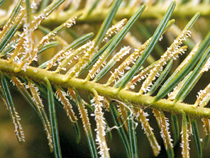 |
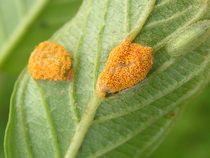 |
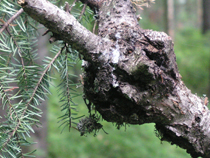 |
|
Gymnosporangium sabinae. Photo: M. Zúbrik |
Pucciniastrum epilobii. Photo: M. Zúbrik | Puccinia coronata. Photo: M. Zúbrik | M. caryophyllacearum. Photo: A. Kunca |
ORDER RUSSULALES
The Russulales order belongs to the Ascomycota phylum. It is divided into 12 families, 80 genera, and 1,767 species (Hawksworth et al., 1995). This group includes russuloid, belowground (hypogeal) species, e.g., Bondarzewia spp., Artomyces spp., etc.. Basidiospores are typically ornamented with amyloid warts or reticulation, although there are exceptions to this rule, e.g., Heterobasidion annosum.



